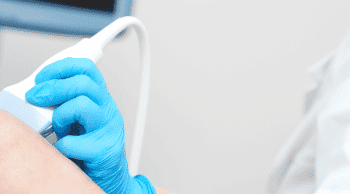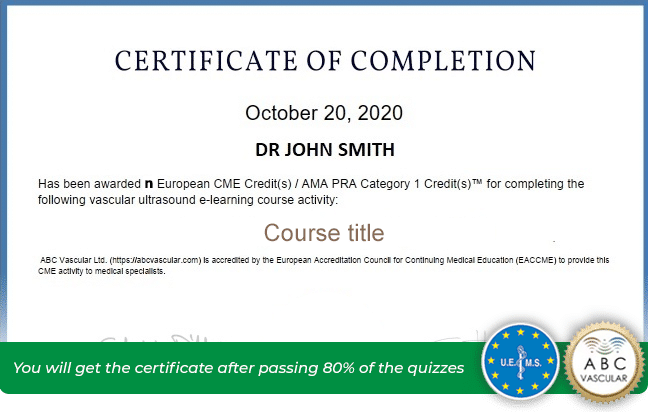

Lower Limb Venous System Course
Master Lower Limb Venous System ultrasound with this course: gain crucial skills for DVT and venous insufficiency assessment. Earn a European certificate and 12 CME credits.

Get Started
About Lower Limb Venous System course
Course Overview
The lower extremity venous system includes the superficial, deep, and perforating veins. The main pathologies that affect the venous system of the lower extremities can be due to the development of thrombosis within the veins or abnormalities in venous valve function.
Deep vein thrombosis (DVT) is a condition in which a blood clot (“thrombus”) forms most often in the deep veins of the legs, groin or arm thus causing partial or complete obstruction of the venous flow.
Although DVT is rarely life-threatening on its own, it has the potential to cause pulmonary embolism (PE), which can be fatal.
The diagnostic approach to suspected symptomatic deep vein thrombosis of the lower extremities is usually based on physical examination and non-invasive methods, including the pretest clinical probability (using the validated Wells score), the measurement of D-dimer levels, and ultrasonography. Venous Ultrasound of the lower limb veins is the first line imaging to detect the presence of a DVT as well as in describing which veins of the legs are involved.
When a thrombus is found within a superficial vein, thi is defined as superficial vein thrombosis (SVT). SVT is most often a complication of varicose veins and, although is not clinically dangerous, a duplex assessment is advised to exclude the presence of a concomitant DVT.
Chronic venous disease, defined as “(any) morphological and functional abnormalities of the venous system of long duration manifest either by symptoms and/or signs indicating the need for investigation and/or care” is a very common and often underdiagnosed disease of the lower limb veins that can impair quality of life.
It can present with different manifestations, ranging from telangiectasias, reticular veins, varicose veins, oedema to skin disorders and venous ulcers.
The exact pathophysiology is debated, but it involves a genetic predisposition, incompetent valves, weakened vascular walls, and increased intravenous pressure. Potential complications include infection, leg ulcers, stasis changes, and SVT.
Aim of this course
Duplex ultrasound (DUS) is the first line diagnostic tool used to assess the anatomy and function of the vascular system. In patients with CVD, it allows to assess the venous system anatomy, evaluate patency and continence of the superficial and deep veins as well as to describe venous incompetence pattern. This information is of paramount importance to define the best treatment plan for individual patients.
This online accredited course is designed to provide ultrasound practitioners with the fundamentals to perform a lower limb venous assessment for deep vein thrombosis and venous insufficiency.
How is the course structured?
The course is made of e-booklets supported by hands-on commented video lectures and covers all the main topics of carotid and vertebral ultrasound imaging, such as:
- the anatomy and the ultrasound appearance of the abdominal and lower limb veins;
- the normal venous haemodynamics as well as the abnormal venous flow and their ultrasound appearance;
Furthermore, the course illustrates the different ultrasound diagnostic criteria and scanning protocols used for:
- the detection and classification of deep and superficial vein thrombosis of the lower limbs;
- he diagnostic criteria used for detecting lower limbs venous incompetence (venous reflux);
- The different patterns of lower limbs varicose veins are also illustrated;
The content of the course is continuously implemented and updated.
What will I get at the end of this course?
At the end of this course, the ultrasound practitioners will have acquired enough knowledge on how to detect a deep and superficial veins thrombosis of the lower limbs as well as how to assess lower limbs for the presence of superficial and deep venous incompetence/reflux.
Learn lower limb venous ultrasound with ABC online courses. At the end of the course an European certificate of accreditation and 12 CME AMA PRA credits will be released to the learner after successfully passing multiple choice quizzes.
Gain an European Certificate
Our courses are accredited by the European accreditation council for continuing medical education to provide CME credits.

Medical e-learning is now widely used by students and healthcare professionals as:
- it offers the possibility to learn at their own pace
without the barriers of location - takes 40% to 60% lesser time for employees and students than conventional learning.

Course includes
- 6 video lectures (> 2 hours)
- 10 e-booklets containing over 300 slides
- real life video cases
- 10 quizzes
- 12 CME or AMA PRA Credits
Course length

- Estimated 12 hours or more to cover videos, slides & quizzes
- Self-paced learning
- Access to this course is for 12 months from date of purchase
Access anywhere

- Mobile friendly
- Learn on-the-go
- Access on PC, phone or tablet
Who may benefit from this course?
Any healthcare professional who is approaching vascular ultrasound for the first time as well as healthcare professionals who want to improve their knowledge and skills in different areas of vascular ultrasound. Our subscribers are:
- trainee medical doctors
- vascular and general sonographers
- nurses
- as well as consultant medical doctors
- as vascular surgeons,
- cardiologists,
- internists,
- angiologists,
- radiologists,
- or somewhat all healthcare professionals involved in the diagnosis and management of peripheral vascular diseases.
Test a lesson free
Not Convinced? Get Started For Free with Two Topics
Start by accessing the first two lessons for FREE. Courses are created by top experts in the field. If you’re new to the ABC learning method and you are not sure whether is right for you, this will help you to understand what to expect from ABC courses.
work at:


Lessons in this course
Start with free access to the sample lessons below. Purchase via credit-card for immediate access to the full course.



Guillaume B.